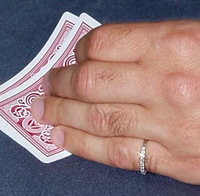
A seal is a device for making an impression in wax, clay, paper, or some other medium, including an embossment on paper, and is also the impression thus made. The original purpose was to authenticate a document, or to prevent interference with a package or envelope by applying a seal which had to be broken to open the container.

An engagement ring, also known as a betrothal ring, is a ring indicating that the person wearing it is engaged to be married, especially in Western cultures. A ring is presented as an engagement gift by a partner to their prospective spouse when they propose marriage or directly after a marriage proposal is accepted. It represents a formal agreement to future marriage. In most Western countries, engagement rings are worn mostly by women, and rings can feature diamonds or other gemstones. The neologism "mangagement ring" is sometimes used for an engagement ring worn by men. In some cultures, including Northern Europe, both partners wear matching rings, and engagement rings may also be used as wedding rings. In the Anglosphere, the ring is customarily worn on the left hand ring finger, but customs vary considerably elsewhere across the world.

An engagement or betrothal is the period of time between the declaration of acceptance of a marriage proposal and the marriage itself. During this period, a couple is said to be fiancés, betrothed,intended, affianced, engaged to be married, or simply engaged. Future brides and grooms may be called fiancée (feminine) or fiancé (masculine), the betrothed, a wife-to-be or husband-to-be, respectively. The duration of the courtship varies vastly, and is largely dependent on cultural norms or upon the agreement of the parties involved.
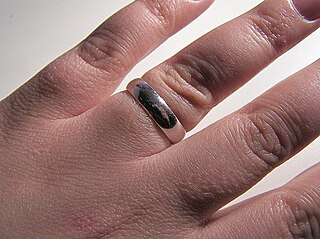
A wedding ring or wedding band is a finger ring that indicates that its wearer is married. It is usually forged from metal, traditionally gold or another precious metal. Rings were used in ancient Rome during marriage.

A Claddagh ring is a traditional Irish ring in which a heart represents love, the crown stands for loyalty, and two clasped hands symbolize friendship.

A necktie, or simply a tie, is a piece of cloth worn for decorative purposes around the neck, resting under the shirt collar and knotted at the throat, and often draped down the chest.

The Crown Jewels of the United Kingdom, originally the Crown Jewels of England, are a collection of royal ceremonial objects kept in the Jewel House at the Tower of London, which include the coronation regalia and vestments worn by British monarchs.

The ring finger, third finger, fourth finger, leech finger, or annulary is the fourth digit of the human hand, located between the middle finger and the little finger.
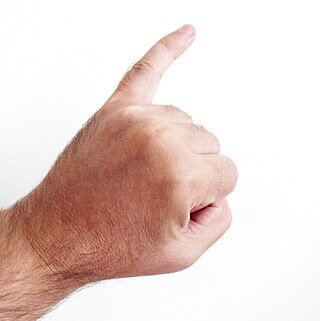
The little finger, or pinkie, also known as the baby finger, Forth Finger, fifth digit, or pinky finger, is the most ulnar and smallest digit of the human hand, and next to the ring finger.
Visual markers of marital status, as well as social status, may include clothing, hairstyle, accessories, jewelry, tattoos, and other bodily adornments. Visual markers of marital status are particularly important because they indicate that a person should not be approached for flirtation, courtship, or sex. In some cultures, married people enjoy special privileges or are addressed differently by members of the community.

A frock coat is a formal men's coat characterised by a knee-length skirt cut all around the base just above the knee, popular during the Victorian and Edwardian periods (1830s–1910s). It is a fitted, long-sleeved coat with a centre vent at the back and some features unusual in post-Victorian dress. These include the reverse collar and lapels, where the outer edge of the lapel is often cut from a separate piece of cloth from the main body and also a high degree of waist suppression around the waistcoat, where the coat's diameter round the waist is less than round the chest. This is achieved by a high horizontal waist seam with side bodies, which are extra panels of fabric above the waist used to pull in the naturally cylindrical drape. As was usual with all coats in the 19th century, shoulder padding was rare or minimal.

A gauntlet is a type of glove that protects the hand and wrist of a combatant. Gauntlets were used particularly in Europe between the early fourteenth century and the early modern period and were often constructed of hardened leather or metal plates.

The Ring of the Fisherman, also known as the Piscatory Ring, is an official part of the regalia worn by the pope, who according to Catholic theology is the head of the Catholic Church and successor of Saint Peter, who was a fisherman by trade. It used to feature a bas-relief of Peter fishing from a boat, a symbolism derived from the tradition that the apostles were "fishers of men". The Fisherman's Ring is a signet used until 1842 to seal official documents signed by the pope. Since at least the Middle Ages it has been a tradition for Catholics meeting the pope to show their devotion by kissing the ring.

In the United States, a class ring is a ring worn by students and alumni to commemorate their final academic year and/or graduation, generally for a high school, college, or university.
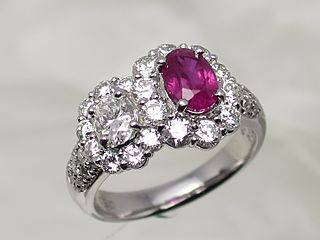
A ring is a round band, usually made of metal, worn as ornamental jewelry. The term "ring" by itself always denotes jewellery worn on the finger; when worn as an ornament elsewhere, the body part is specified within the term, e.g., earrings, neck rings, arm rings, and toe rings. Rings always fit snugly around or in the part of the body they ornament, so bands worn loosely, like a bracelet, are not rings. Rings may be made of almost any hard material: wood, bone, stone, metal, glass, gemstone or plastic. They may be set with gemstones or with other types of stone or glass.

Khmer traditional clothing refers to the traditional styles of dress worn by the Khmer people from ancient times to the present.

Queen Elizabeth II owned a historic collection of jewels – some as monarch and others as a private individual. They are separate from the gems and jewels of the Royal Collection, and from the coronation and state regalia that make up the Crown Jewels.

The wedding of Princess Elizabeth and Philip Mountbatten took place on Thursday 20 November 1947 at Westminster Abbey in London, United Kingdom. The bride was the elder daughter of King George VI and Queen Elizabeth as well as the heir presumptive to the British throne. The groom was born a Greek and Danish prince; he stopped using these foreign titles on his adoption of British nationality four months before the announcement of their marriage and was made Duke of Edinburgh, Earl of Merioneth and Baron Greenwich on the morning of the wedding.
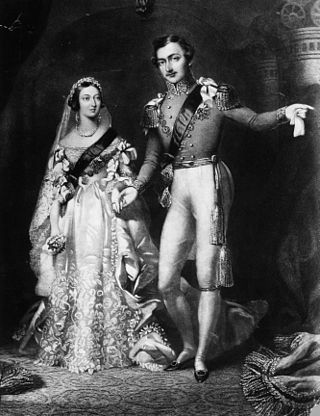
Queen Victoria of the United Kingdom married Prince Albert of Saxe-Coburg and Gotha on 10 February 1840. She chose to wear a white wedding dress made from heavy silk satin, making her one of the first women to wear white for their wedding. The Honiton lace used for her wedding dress proved an important boost to Devon lace-making. Queen Victoria has been credited with starting the tradition of white weddings and white bridal gowns, although she was not the first royal to be married in white.
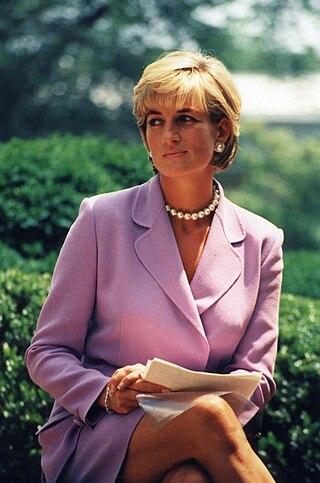
Diana, Princess of Wales, owned a collection of jewels both as a member of the British royal family and as a private individual. These were separate from the coronation and state regalia of the crown jewels. Most of her jewels were either presents from foreign royalty, on loan from Queen Elizabeth II, wedding presents, purchased by Diana herself, or heirlooms belonging to the Spencer family.
